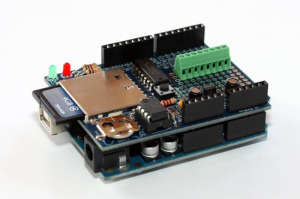Implementing large-scale sensor deployment for watershed assessment has previously been limited by the high cost of the datalogging and communication infrastructure.
Stroud Water Research Center is overcoming the obstacles to large near-real-time data collection networks by using Arduino, an open source electronics platform, in combination with XBee ZigBee wireless radio modules.
The open source nature of Arduino means the cost is extremely low compared to similar commercial electronics options.
By significantly decreasing the cost of the datalogging and communication hardware, resources can be focused on installing more sensors for greater spatial coverage.
Researchers, students, and individuals can easily build and deploy inexpensive dataloggers without the need for electronics experience, complicated software, or specialized tools. Dozens of low cost boards allow even novice users to build devices using boards that connect in a modular framework.
Benefits of Open-Source Datalogger Hardware
- Low Cost: For around $150, we can replicate the capabilities of a $3000 wireless commercial datalogger system.
- Ease of use: The Arduino electronics prototyping platform was initially designed “for artists, designers, hobbyists, and anyone interested in creating interactive objects or environments.” As such, the Arduino family of electronics hardware is easy to snap together and program; yet it is also capable of nearly any task we might imagine.
- Support: The large user community provides support as well as constant innovation and development of new hardware and applications
- Reliability: Self-healing mesh wireless networks route the radio signal from the nodes to the base station using the most efficient route. Each node also has a removable memory card to store a backup of the sensor data
- Compatibility: Commercial dataloggers can join an Arduino mesh network by simply connecting an Xbee radio module to the logger so it can transmit the data that it usually only stores on its internal memory
Building the Networks
- Datalogger nodes consist of a microprocessor board paired with a radio module, all mounted in a weatherproof enclosure along with a solar panel and rechargeable battery.
- The nodes conserve battery power by sleeping most of the time, then waking periodically to take measurements from the sensors, and then transmitting their data through the mesh back to the base before going back to sleep.
- In areas with no mesh network, standalone loggers with just a memory card can be used.
Custom Devices
Other custom devices such as a remote streamwater sampling system and a multi-chamber respirometer controller can be built using the same type of Arduino microprocessor boards.
Our Preliminary Results
We believe that using open-source electronics hardware for watershed instrumentation will transform our ability to deploy sensors, field instruments, and other electronic “eyes and ears” to unprecedented levels. High quality commercial sensors are relatively inexpensive and widely available. Easy customization of the Arduino node interface hardware and software means virtually any sensor can be used.
As we finalize our electrical designs and Arduino programming code, we will be sharing all of the documentation for our loggers and other devices so anyone can replicate and implement their own versions of our instrumentation.

 Welcome to EnviroDIY, a community for do-it-yourself environmental science and monitoring. EnviroDIY is part of
Welcome to EnviroDIY, a community for do-it-yourself environmental science and monitoring. EnviroDIY is part of 
